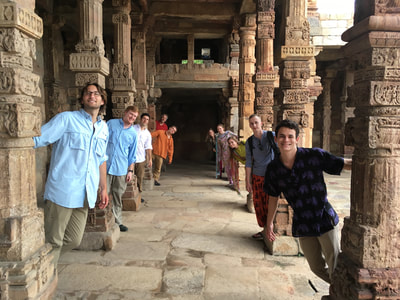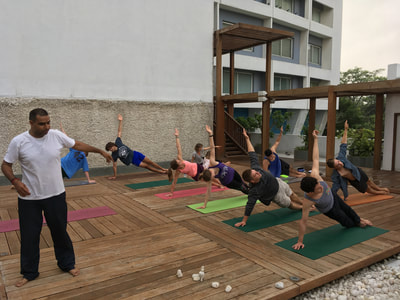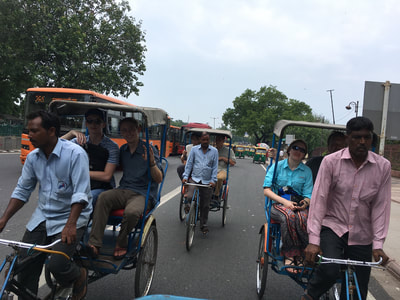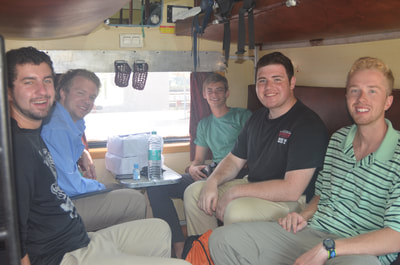Delhi, India

Delhi set the stage for the rest of the India trip. The 3-4 days spent in the city gave students a chance to get over their initial culture shock and jet lag while diving headfirst into the vast history of India.
If the history of India were a book and each page was a year, it would be approximately 5000 pages long. Professor Najaf Haider, a medieval history professor in Delhi, taught the students about the history of India. There was a visit to the National Museum as well as ancient sites like Qutab-Minar.
After learning about ancient India, students visited Mughal sites from the 800 year period when India was ruled by the Muslims. These visits included the Lodhi Gardens and Humayun’s Tomb which served as early inspiration for the Taj Mahal.
India is home to a wide variety of religions, so students visited the mosque in Jama Masjid and the Akshardham Hindu Temple to study Islam and Hinduism and the effects the religions have on society today.
Then, there were visits to British India including the India gate and parliament buildings. When the British took over, they built a new part of the city and named it New Delhi. They also visited the Gandhi Smriti, the place where Gandhi spent the final days of his life, and the Raj Ghat, where Gandhi was cremated.
Students had the chance to eat at traditional Indian restaurants and shop in the local stores for traditional Indian clothes to wear for the rest of the trip.
If the history of India were a book and each page was a year, it would be approximately 5000 pages long. Professor Najaf Haider, a medieval history professor in Delhi, taught the students about the history of India. There was a visit to the National Museum as well as ancient sites like Qutab-Minar.
After learning about ancient India, students visited Mughal sites from the 800 year period when India was ruled by the Muslims. These visits included the Lodhi Gardens and Humayun’s Tomb which served as early inspiration for the Taj Mahal.
India is home to a wide variety of religions, so students visited the mosque in Jama Masjid and the Akshardham Hindu Temple to study Islam and Hinduism and the effects the religions have on society today.
Then, there were visits to British India including the India gate and parliament buildings. When the British took over, they built a new part of the city and named it New Delhi. They also visited the Gandhi Smriti, the place where Gandhi spent the final days of his life, and the Raj Ghat, where Gandhi was cremated.
Students had the chance to eat at traditional Indian restaurants and shop in the local stores for traditional Indian clothes to wear for the rest of the trip.
Overnight Train Ride

The best way to travel from Delhi to the remote town of Khajuraho is by an overnight train. Train travel is the most common form of transportation utilized by Indian citizens so it offers a unique opportunity to understand more of the culture and geography of India.
The train cars and full of open compartments that each have two-three tiers of bunk beds. The beds are small, there is little privacy, and the bathrooms are basic.
Spending a night on the train allowed students to see the process of rural-urban migration. There were families that sit in the train station with all their belongings, waiting for the next train to take them to the city to start their new life. There were also gypsies, nomadic people who have for centuries roamed India, equipped with tents and their artisan skills. They wait for the next train to take them to a new stop where they can find work to be done. The train rides provided time for the group to get to know each other. The many hours on the train were spent doing homework, playing group games, or even playing guitar and singing Sweet Home Alabama.
The train cars and full of open compartments that each have two-three tiers of bunk beds. The beds are small, there is little privacy, and the bathrooms are basic.
Spending a night on the train allowed students to see the process of rural-urban migration. There were families that sit in the train station with all their belongings, waiting for the next train to take them to the city to start their new life. There were also gypsies, nomadic people who have for centuries roamed India, equipped with tents and their artisan skills. They wait for the next train to take them to a new stop where they can find work to be done. The train rides provided time for the group to get to know each other. The many hours on the train were spent doing homework, playing group games, or even playing guitar and singing Sweet Home Alabama.






















